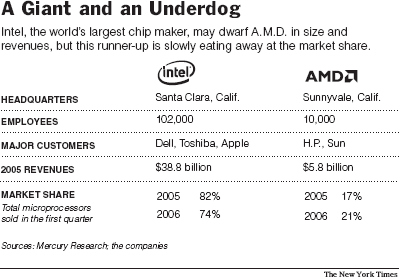
Phil Hester, apparently a chip hotshot, joined A.M.D. ten months ago as its technology chief, to "help lead its battle against Intel." (Hector Ruis, mentioned below, is the C.E.O. of A.M.D.)
Mr. Hester and other A.M.D. executives say that the technology in its laboratories gives them plenty of reason for optimism, and that in some product categories Intel is just catching up to advances A.M.D. pioneered. Just next month, for example, A.M.D. is expected to introduce improvements to Opteron, and both companies are designing chips to run cooler and consume less energy.
Much like Intel, A.M.D. is working to increase the number of processors on each chip from two to four, and the company says it will introduce new designs for servers and desktop systems that will be released in mid-2007, followed later in the year by a new design for notebooks. Many analysts are also expecting the company to counter Intel’s pricing moves with price cuts of its own. At A.M.D.’s annual conference for analysts last month, Mr. Hester also disclosed an unusual plan to let other manufacturers build chips that work closely with its own chips, indicating an openness and flexibility that has not been seen before in the company’s strategy.
With that effort, referred to as Torrenza, A.M.D. is licensing some of its chip specifications to other technology developers so they can add specialized functions, like advanced graphics and math processing.
“We want to open up our technology and unleash a completely new wave of innovation,” Mr. Ruiz told analysts at the conference.
Advanced Micro has picked up about five percentage points of market share over the past year, nearly all of that from Intel, according to Mercury Research. Today, A.M.D.’s overall share is about 21 percent, to Intel’s 74 percent, and at the analyst meeting Mr. Ruiz said the goal was to have a 30 percent share by 2008.
Mr. Hester said A.M.D.’s road map for new products had not changed much since his arrival. Mostly he has focused on improving the way employees manage projects and pushing them to develop multiple designs at one time. He said he also emphasized cooperation inside development teams, rather than having teams compete for attention.
The competitive situation has helped with this. “Being the underdog creates a culture of cooperation,” Mr. Hester said.
For the full story, see:
(Note: the online version of the article has a different title, viz., "A.M.D. Seeks to Gain in Its Rivalry With Intel.")

